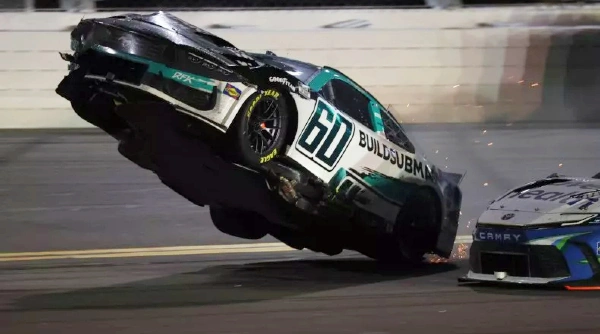The Daytona 500 once again has ignited discussions about safety in NASCAR after Ryan Preece’s No. 60 Ford was involved in a violent crash that saw his car lift off the ground and point skyward before flipping onto it’s roof and back over again while sliding up the track. The car then collided with the SAFER barrier, bounced off and tumbled dramatically down the banking before finally coming to rest on the apron. The incident marked the second time that Preece has experienced such a wreck, raising concerns over whether NASCAR is doing enough to prevent cars from going airborne during superspeedway crashes.
Preece’s comments after the crash were telling: “I don’t know if it’s the diffuser or what that makes these cars like a sheet of plywood when you walk out on a windy day. When the car took off like that, all I thought about was my daughter. I’m lucky I got to walk away, but we’re getting closer and closer to someone not being able to.” His fear and comments in the moment are understandable, but the situation also presents an interesting contradiction. Despite flipping in dramatic fashion at Daytona in August of 2023 and sustaining broken vessels in both eyes from the impact, Preece was not deterred. When questioned the following weekend, his reaction to the wreck was remarkably unbothered by it. And he showed no fear or hesitancy when he climbed behind the wheel for yet another superspeedway race with the fall running of Talladega just one month and three days later. At that point, his daughter was just seven weeks old and he knew the potential for something similar to happen again. He also continued on with six superspeedway races during the 2024 season. After Stewart-Haas Racing shut down, he willingly joined RFK Racing – an organization that undoubtedly would put him in a faster car. If he truly believed that superspeedway wrecks are moving toward a fatality, he had the option to walk away.
Even more ironic is the fact that Preece’s current boss and team mate at RFK, Brad Keselowski, initiated the conversation of making the car’s underbody smooth and flat—an idea he discussed years ago on NASCAR Race Hub. At the time, Keselowski suggested that it would improve passing on intermediate tracks, which was a major struggle for the Gen 6 car. Clearly, NASCAR adopted the concept with the introduction of the Gen 7 car, but now that same smooth underbody, paired with a diffuser, may be contributing to these violent flips. And Keselowski’s own driver is raising concerns.
NASCAR has implemented numerous safety measures over the years to reduce the risk of cars flipping. Roof flaps were introduced in 1994, designed to disrupt airflow and prevent potential lift-offs during spins. The backstretch grass at Daytona was removed and the surface was paved to eliminate the possibility of a car digging into the soft ground and flipping. Following Corey LaJoie’s airborne crash at Michigan in 2024, NASCAR added a second shark-fin style roof rail, this time to the right side of the car. The device was created to increase the velocity needed for the car to flip by about 15 to 20%. The cars are already engineered to be pinned to the ground with splitters and side skirts that run mere millimeters above the track surface. Yet, despite these changes, the flips continue.
It’s worth noting that six of the last seven flips have involved just three drivers: Josh Berry, Corey LaJoie, and Ryan Preece. Whether that’s coincidence or not is debatable, but it does raise the question of whether these incidents are a broader design flaw or if certain factors—such as positioning, blocking, or aggressive driving styles—play a role in who gets caught up in these airborne wrecks.
The core issue here is not whether NASCAR should continue to prioritize safety—they have and always will. The real concern is whether the sport is at risk of overcorrecting based on public pressure. The demand to “do something” every time an incident occurs has led to frequent rule changes, some of which have had unintended and cirtically panned consequences. Superspeedway racing has already suffered from teams prioritizing fuel mileage and “riding” instead of racing all-out. Further changes aimed at preventing flips could fundamentally alter the dynamics of these events, potentially making the racing even worse or—ironically—creating new safety concerns that haven’t been anticipated.
Undoubtedly, Preece’s latest flip was frightening, but it should also serve as a reminder that risk is an inherent part of the sport. Every driver who straps into a race car understands that. Just as every police officer, fireman, and member of the military understands what they are risking when they choose their career. The reality is that the same high speed danger that drivers fear is also part of what draws them to the sport in the first place. Absolutely no one wants to see another catastrophic crash, but it’s also worth asking: How much more can be done before the sport itself is no longer recognizable?

